4.E: Functions of Two Variables (Exercises)
- Last updated
- Aug 2, 2021
- Save as PDF
- Page ID
- 80911
( \newcommand{\kernel}{\mathrm{null}\,}\)
4.1 Exercises
Exercise 4.E.1
F(x,y)=x2−y2. Find
a) F(0,4)
b) F(4,0)
c) F(x,4)
d) F(4,y)
e) F(800,800)
f) F(x,x)
g) F(x,−x)
Exercise 4.E.2
g(s,t)=√st2. Find
a) g(1,9)
b) g(9,1)
c) g(1,t)
d) g(s,9)
e) g(w,z+1)
Exercise 4.E.3
Let f(x,y,z,w)=x2−1zw+xyz2. Evaluate f(1,2,3,4).
Exercise 4.E.4
Let f(x,y,z,w)=√xy−w2+102yz. Evaluate f(1,2,3,4).
Exercise 4.E.5
Here is a table showing the function A(t,r)
| t↓ r→ |
.03 |
.04 |
.05 |
.06 |
.07 |
|
1 |
30.45 |
40.81 |
51.27 |
61.84 |
72.51 |
|
2 |
61.84 |
83.29 |
105.17 |
127.50 |
150.27 |
|
3 |
94.17 |
127.50 |
161.83 |
197.22 |
233.68 |
a) Find A(2,.05)
b) Find A(.05,.2)
c) Is A(t,.06) an increasing or decreasing function of t?
d) Is A(3,r) an increasing or decreasing function of r?
Exercise 4.E.6
Here is a table showing values for the function H(t,h).
| t↓ h→ |
100 |
150 |
200 |
|
0 |
100 |
150 |
200 |
|
1 |
110.1 |
160.1 |
210.1 |
|
2 |
110.4 |
160.4 |
210.4 |
|
3 |
100.9 |
150.9 |
200.9 |
|
4 |
81.6 |
131.6 |
181.6 |
|
5 |
52.5 |
102.5 |
152.5 |
a) Is H(t,150) an increasing or decreasing function of t?
b) Is H(4,h) an increasing or decreasing function of h?
c) Fill in the blanks: The maximum value shown on this table is H(___,___) =____.
d) Fill in the blanks: The minimum value shown on this table is H(___,___) =____.
Exercise 4.E.7−4.E.10
In problems 7 – 10, plot the given points.
7. A=(0,3,4),B=(1,4,0),C=(1,3,4),D=(1,4,2)
8. E=(4,3,0),F=(3,0,1),G=(0,4,1),H=(3,3,1)
9. P=(2,3,–4),Q=(1,–2,3),R=(4,–1,–2),S=(–2,1,3)
10. T=(–2,3,–4),U=(2,0,–3),V=(–2,0,0),W=(–3,–1,–2)
Exercise 4.E.11−4.E.14
In problems 11 – 14, calculate the distances between the given points
11. A=(5,3,4),B=(3,4,4)
12. A=(6,2,1),B=(3,2,1)
13. A=(3,4,2),B=(–1,6,–2)
14. A=(–1,5,0),B=(1,3,2)
Exercise 4.E.15−4.E.18
In problems 15 – 18, graph the given planes.
| 15. y=1 and z=2 | 16. x=4 and y=2 |
| 17. x=1 and y=0 | 18. x=2 and z=0 |
Exercise 4.E.19−4.E.22
In problems 19 – 22, the center and radius of a sphere are given. Find an equation for the sphere.
| 19. Center = (4, 3, 5), radius = 3 | 20. Center = (0, 3, 6), radius = 2 |
| 21. Center = (5, 1, 0), radius = 5 | 22. Center = (1, 2, 3), radius = 4 |
Exercise 4.E.23−4.E.24
In problems 23 – 24, the equation of a sphere is given. Find the center and radius of the sphere.
| 23. (x–3)2+(y+4)2+(z–1)2=16 | 24. (x+2)2+y2+(z–4)2=25 |
Exercise 4.E.25−4.E.30
For problems 25 through 30. Match the contour diagram to the computer-generated, perspective drawing (a through f) it matches. Briefly explain your answer.
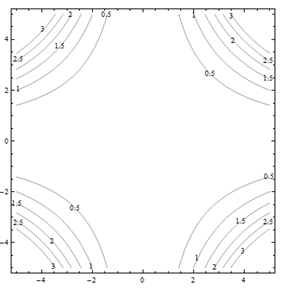
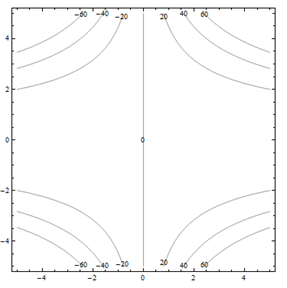
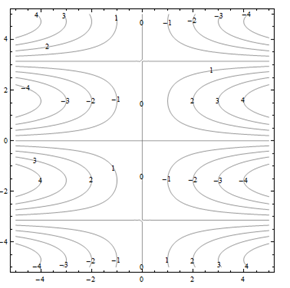
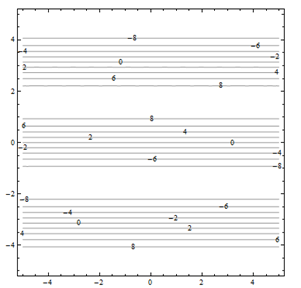
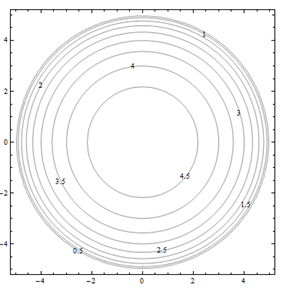
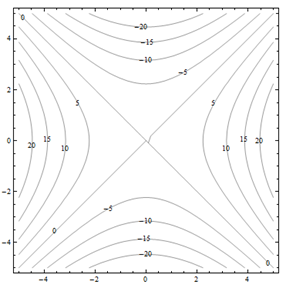
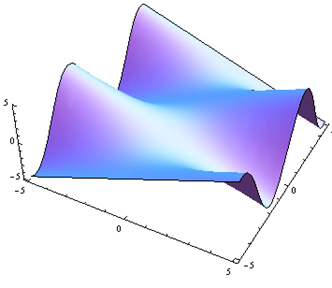

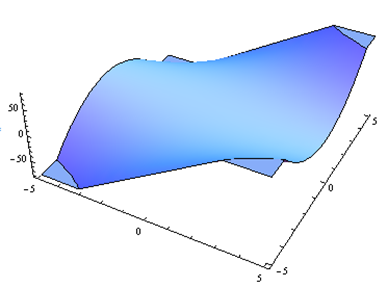
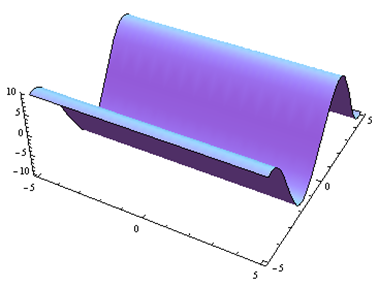
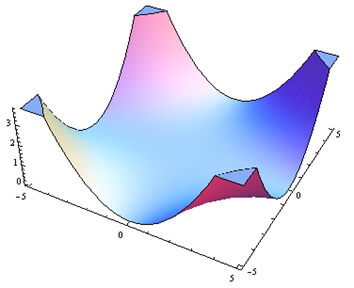
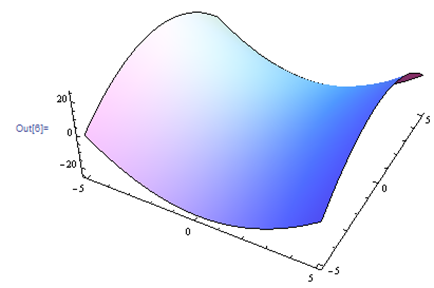
Exercise 4.E.31−4.E.36
For problems 31 through 36. Match the contour diagram to the equation (a through f) it matches. Briefly explain your answer.
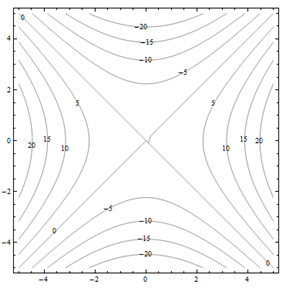
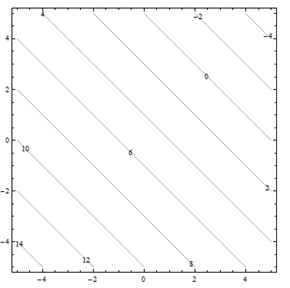
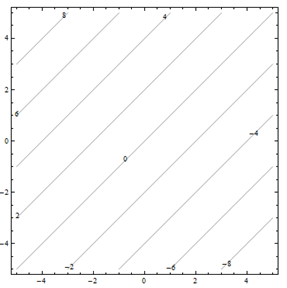
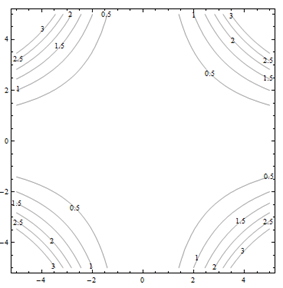
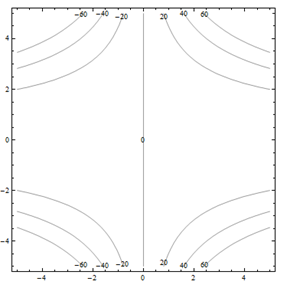
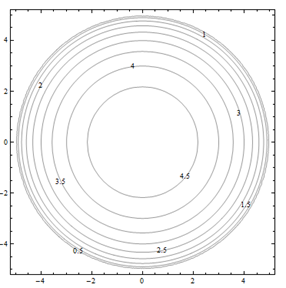
| a. f(x,y)=y−x | b. f(x,y)=xy2 |
| c. f(x,y)=√25−x2−y2 | d. f(x,y)=5−x−y |
| e. f(x,y)=0.01x2y2 | f. f(x,y)=x2−y2 |
Exercise 4.E.37
The contour diagram shown is for a function M(x,y).
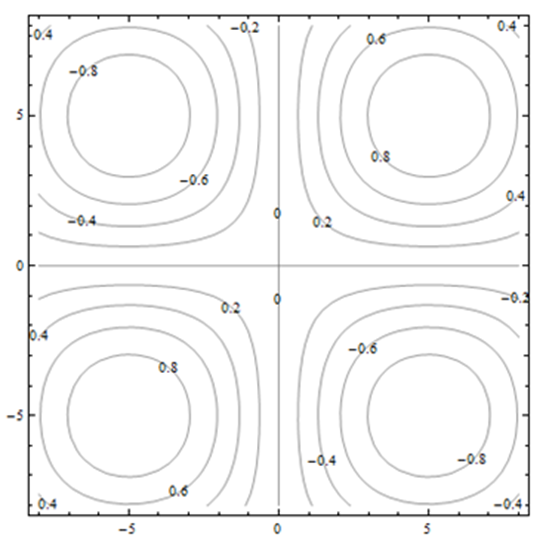
Use the diagram to answer the following:
a) Estimate M(1,3)
b) Estimate M(3,1)
c) Is M(x,3) an increasing or decreasing function of x?
d) Is M(3,y) an increasing or decreasing function of y?
e) Find a value of c so that M(c,y) is a constant function of y.
Exercise 4.E.38
The contour diagram shown is for a function G(x,y).
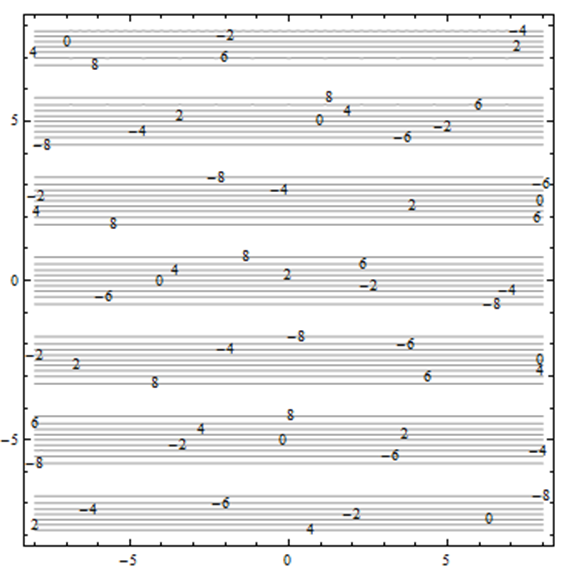
Use the diagram to answer the following:
a) Estimate G(2,3)
b) Suppose you travel north (in the direction of increasing y) along the surface, starting above (2, 3). Describe your journey.
c) Suppose you travel east (in the direction of increasing x) along the surface, starting above (2, 3). Describe your journey.
Exercise 4.E.39
The demand functions for two products are given below. p1, p2, q1, and q2 are the prices (in dollars) and quantities for products 1 and 2. Are these two products complementary goods or substitute goods
q1=200−3p1+p2
q2=150+p1−2p2
Exercise 4.E.40
The demand functions for two products are given below. p1, p2, q1, and q2 are the prices (in dollars) and quantities for products 1 and 2. Are these two products complementary goods or substitute goods
q1=350+p1+2p2
q2=225+p1+p2
Exercise 4.E.41
Consider the Cobb-Douglas Production function: P(L,K)=11L0.3K0.7. Find the total units of production when 19 units of labor and 12 units of capital are invested.
Exercise 4.E.42
Consider the Cobb-Douglas Production function: P(L,K)=6L0.6K0.4. Find the total units of production when 24 units of labor and 8 units of capital are invested.
4.2 Exercises
Exercise 4.E.1−4.E.16
For problems 1 through 16, find fx and fy for the function given
| 1. f(x,y)=x2−5y2 |
| 2. f(x,y)=x2−5y2x+4 |
| 3. f(x,y)=ex+6y |
| 4. f(x,y)=(x2−5y2)ex |
| 5. f(x,y)=(x2−5y2)(13y+4) |
| 6. f(x,y)=x |
| 7. f(x,y)=6 |
| 8. f(x,y)=ln(xy+2x−6y) |
| 9. f(x,y)=x2−5y2y4−5x4 |
| 10. f(x,y)=e√x−4y(x−4y) |
| 11. f(x,y)=y5ex |
| 12. f(x,y)=116xy |
| 13. f(x,y)=(x+ey)7 |
| 14. f(x,y)=x4+4x3y−6x2y2−4xy3+y4 |
| 15. f(x,y)=√x+√y |
| 16. f(x,y)=x2y3−4x3 |
Exercise 4.E.17
Here is a table showing the function A(t,r)
| t↓ r→ |
.03 |
.04 |
.05 |
.06 |
.07 |
|
1 |
30.45 |
40.81 |
51.27 |
61.84 |
72.51 |
|
2 |
61.84 |
83.29 |
105.17 |
127.50 |
150.27 |
|
3 |
94.17 |
127.50 |
161.83 |
197.22 |
233.68 |
a. Estimate At(2,.05).
b. Estimate Ar(2,.05)
c. Use your answers to parts a and b to estimate the value of A(2.5,.054)
d. The values in the table came from A(t,r)=1000(ert−1), which shows the interest earned if 1000 dollars is deposited in an account earning r annual interest, compounded continuously, and left there for t years. How close are your estimates from parts a, b, and c?
Exercise 4.E.18
18. Here is a table showing values for the function H(t,h).
| t↓ h→ |
100 |
150 |
200 |
|
0 |
100 |
150 |
200 |
|
1 |
110.1 |
160.1 |
210.1 |
|
2 |
110.4 |
160.4 |
210.4 |
|
3 |
100.9 |
150.9 |
200.9 |
|
4 |
81.6 |
131.6 |
181.6 |
|
5 |
52.5 |
102.5 |
152.5 |
a. Estimate the value of ∂Hdt at (3, 150).
b. Estimate the value of ∂Hdh at (3, 150).
c. Use your answers to parts a and b to estimate the value of H(2.6,156).
d. The values in the table came from H(t,h)=h+15t−4.9t2, which gives the height in meters above the ground after t seconds of an object that is thrown upward from an initial height of h meters with an initial velocity of 15 meters per second. How close are your estimates from parts a, b, and c?
Exercise 4.E.19
Given the function f(x,y)=x2√y
a. Calculate f(2,4), fx(2,4), and fy(2,4)
b. Use your answers from part a to estimate f(1.9,4.1)
Exercise 4.E.20
Given the function f(x,y)=ln(10−x2−y)
a. Calculate f(2,5), fx(2,5), and fy(2,5)
b. Use your answers from part a to estimate f(1.8,4.8)
Exercise 4.E.21−4.E.26
In problems 21 - 26, use the contour plot shown to estimate the desired value.
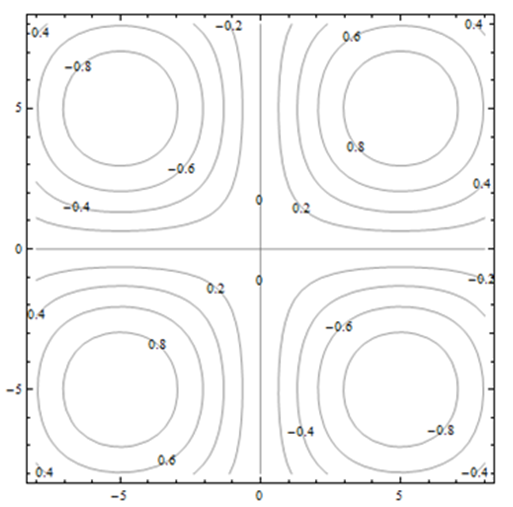
| 21. fx(1,−5) |
| 22. fx(−5,2) |
| 23. fx(5,5) |
| 24. fx(0,0) |
| 25. fy(1,−5) |
| 26. fy(−5,2) |
4.3 Exercises
Exercise 4.E.1−4.E.6
For problems 1 through 6, find fxx, fyy, fxy and fyx for the function given. Confirm that fxy=fyx.
| 1. f(x,y)=x2−5y2 |
| 2. f(x,y)=x4+4x3y−6x2yy−4xy3+y4 |
| 3. f(x,y)=5x2y2 |
| 4. f(x,y)=ex+6y |
| 5. f(x,y)=ln(xy+2x−6y) |
| 6. f(x,y)=x2y4−5 |
Exercise 4.E.7
Find the critical points of f(x,y)=y3−x3+15x2−12y+12 and use the Second Derivative Test to classify them. If the test fails, say “the test fails.”
Exercise 4.E.8
Find the critical points of f(x,y)=2xy−x2−2y2+6x+4 and use the Second Derivative Test to classify them. If the test fails, say “the test fails.”
Exercise 4.E.9
Find the critical points of f(x,y)=y2−4ln(x)+4x and use the Second Derivative Test to classify them. If the test fails, say “the test fails.”
Exercise 4.E.10
Find the critical points of f(x,y)=xy−6x2+3x−y+2 and use the Second Derivative Test to classify them. If the test fails, say “the test fails.”
Exercise 4.E.11
The origin is a critical point for the function f(x,y)=x3+y3, and D=0 there. That is, the Second Derivative Test fails. Use what you know about shapes of functions to decide if there is a local minimum, local maximum, or saddle point for this function at (0, 0).
Exercise 4.E.12
The origin is a critical point for the function f(x,y)=15−x2y2, and D=0 there. That is, the Second Derivative Test fails. Use what you know about shapes of functions to decide if there is a local minimum, local maximum, or saddle point for this function at (0, 0).
Exercise 4.E.13−4.E.18
For problems 13 through 18, find all local maxima, minima, and saddle points for the function.
| 13. f(x,y)=xy−5x2−5y2+33y |
| 14. f(x,y)=10xy−x2−y2+3x |
| 15. f(x,y)=x3+y3−3xy |
| 16. f(x,y)=5x2−4xy+2y2+4x−4y+10 |
| 17. f(x,y)=y2ex+x2 |
| 18. f(x,y)=xy+2x−ln(x2y), for x>0 and y>0. |
Exercise 4.E.19
The demand functions for two products are given below. p1, p2, q1, and q2 are the prices (in dollars) and quantities for products 1 and 2.
q1=200+3p1+p2
q2=150+p1+2p2
a. Are these two products complementary goods or substitute goods?
b. What is the quantity demanded for each when the price for product 1 is $20 per item and the price for product 2 is $30 per item?
c. Write a function R(p1,p2) that expresses the total revenue from these two products.
d. Find the price and quantity for each product that maximizes the total revenue.
Exercise 4.E.20
The demand functions for two products are given below. p1, p2, q1, and q2 are the prices (in dollars) and quantities for products 1 and 2.
q1=350+p1+2p2
q2=225+p1+p2
a. Are these two products complementary goods or substitute goods?
b. What is the quantity demanded for each when the price for product 1 is $20 per item and the price for product 2 is $30 per item?
c. Write a function R(p1,p2) that expresses the total revenue from these two products.
d. Find the price and quantity for each product that maximizes the total revenue.
Exercise 4.E.21
Suppose the demand functions for two products are q1=f(p1,p2) and q2=g(p1,p2), where p1, p2, q1, and q2 are the prices (in dollars) and quantities for products 1 and 2. Consider the four partial derivatives ∂q1∂p1, ∂q1∂p2, ∂q2∂p1, and ∂q2∂p2. Tell the sign of each of these partial derivatives if
a. the products are complementary goods.
b. the products are substitute goods.

